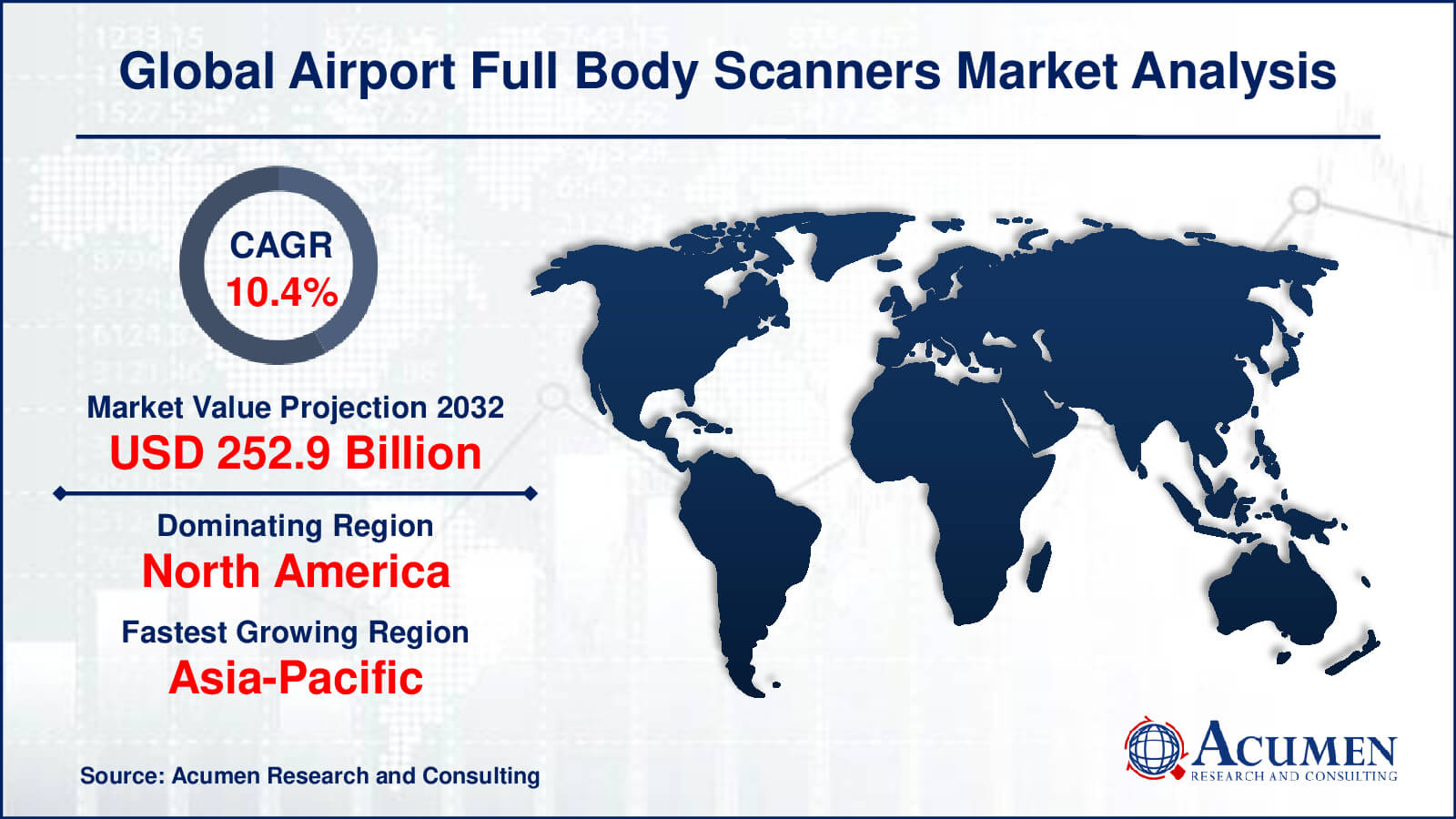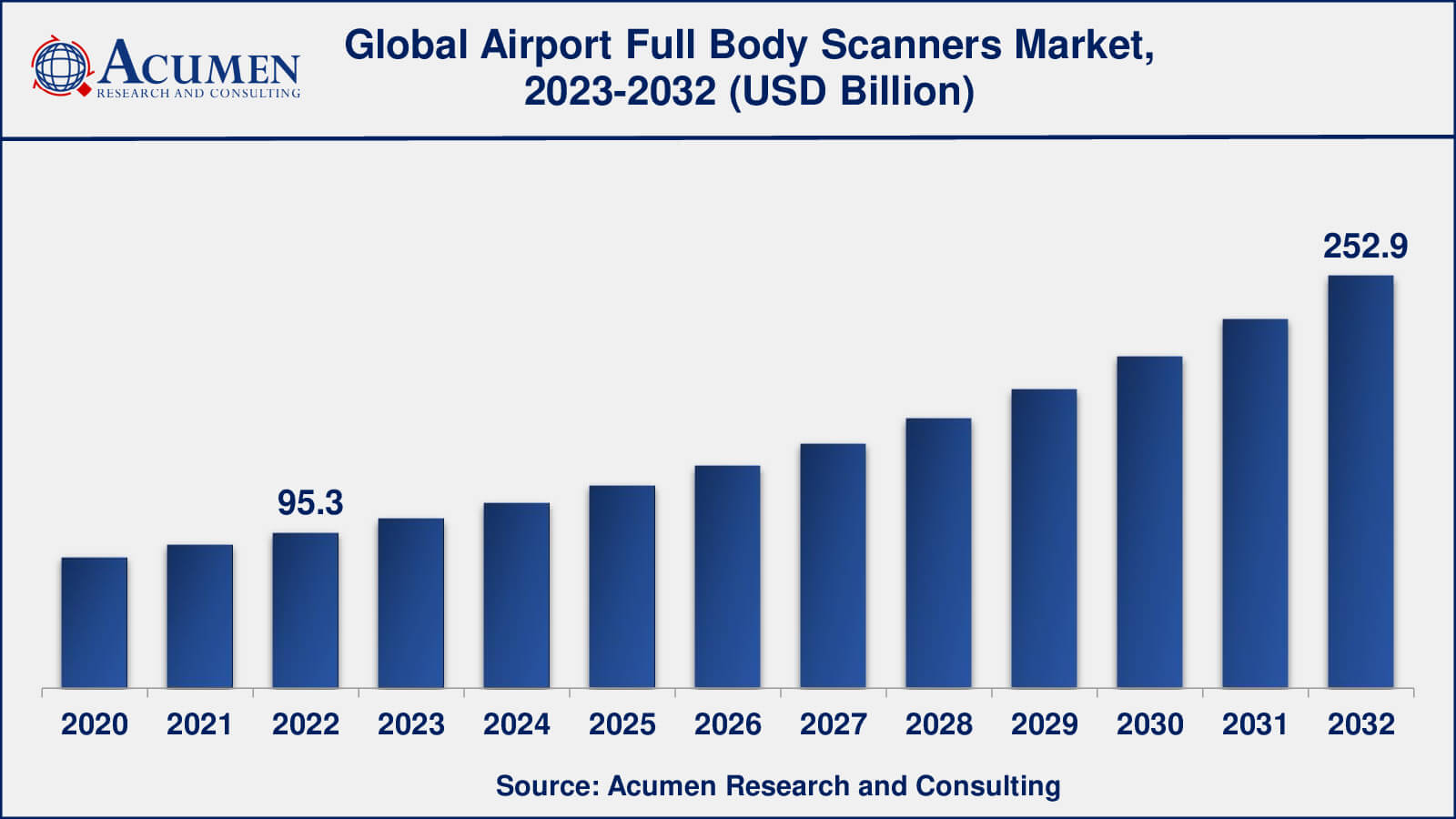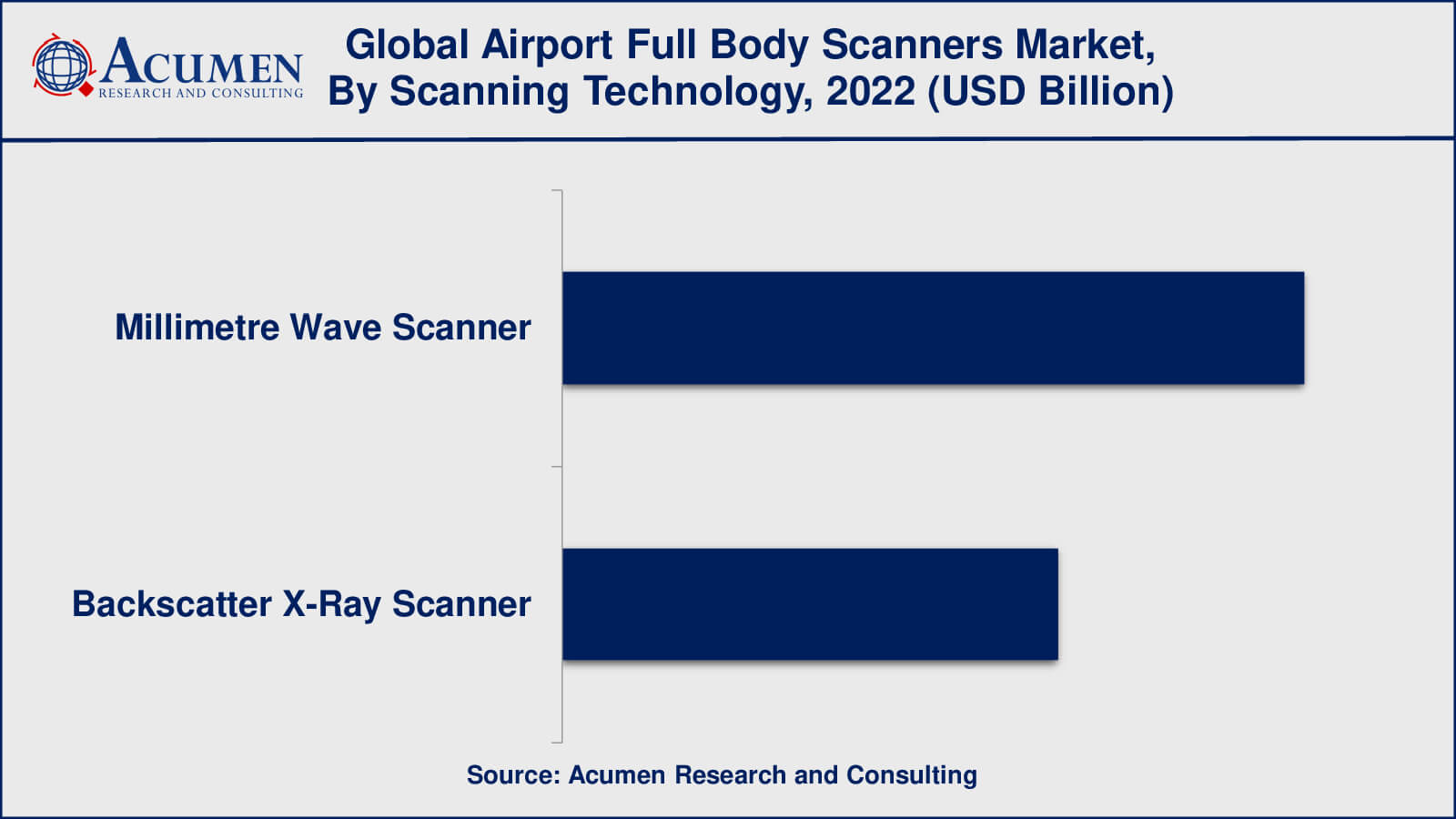June 2023
Airport Full Body Scanners Market Size collected USD 95.3 Billion in 2022 and is set to achieve a market size of USD 252.9 Billion in 2032 growing at a CAGR of 10.4% from 2023 to 2032.
The Global Airport Full Body Scanners Market Size collected USD 95.3 Billion in 2022 and is set to achieve a market size of USD 252.9 Billion in 2032 growing at a CAGR of 10.4% from 2023 to 2032.
Airport Full Body Scanners Market Report Statistics

An airport full body scanner is generally used to detect critical threats to national security and aviation. The full body scanners let a security official check any hidden objects on a person’s clothes or body. Full body scanners stand as the next step in airport security overcoming metal detecting scanners. Full body scanners are critically effective equipment in the security screening sector. Full body scanners are electronic devices that help in detecting suspicious objects during security checks. These types of scanners are particularly used in areas that require high strategic importance and high-security vigilance including defense headquarters, VVIP residences, and airports among others. Full body scanners help the invigilators or operators to spot images of the person’s body with alternate wavelengths and aid in the detection of suspicious objects hidden under the prosthetics or attire. In comparison to metal detectors, full body scanners are capable of detecting non-metal objects like surgically implanted bombs and non-metallic bombing equipment.

Global Airport Full Body Scanners Market Dynamics
Market Drivers
Market Restraints
Market Opportunities
Airport Full Body Scanners Market Report Coverage
| Market | Airport Full Body Scanners Market |
| Airport Full Body Scanners Market Size 2022 | USD 95.3 Billion |
| Airport Full Body Scanners Market Forecast 2032 | USD 252.9 Billion |
| Airport Full Body Scanners Market CAGR During 2023 - 2032 | 10.4% |
| Airport Full Body Scanners Market Analysis Period | 2020 - 2032 |
| Airport Full Body Scanners Market Base Year | 2022 |
| Airport Full Body Scanners Market Forecast Data | 2023 - 2032 |
| Segments Covered | By Scanning Technology, By Airport Type, And By Geography |
| Regional Scope | North America, Europe, Asia Pacific, Latin America, and Middle East & Africa |
| Key Companies Profiled | Rapiscan Systems Ltd., Millivision Inc., L-3 Communications Holdings, Inc., Brijot Imaging Systems, American Science & Engineering Group, Braun & Company Ltd. and Tek84 Engineering Group LLC. |
| Report Coverage |
Market Trends, Drivers, Restraints, Competitive Analysis, Player Profiling, Covid-19 Analysis, Regulation Analysis |
Airport Full Body Scanners Market Growth Factors
An increase in terrorist activities and rising threats to key economies have propelled the governing bodies to employ aviation threat controls. For instance, Federal Aviation Administration (FAA) augmented the surveillance scanning mechanisms across the country’s exit and entry points. Installation of full body scanners at airports facilitates in reducing fraudulent activities such as narcotics, smuggling of diamonds, weapons, and other illegal/expensive items. The impact of terrorist activities has been efficiently reduced owing to the use of security screening systems and full body scanners as the major systems. Moreover, rising awareness of airport security and upcoming airport constructions across developing countries have added to the adoption of airport full-body scanners.
However, issues related to the privacy of certain passengers such as images of their bare bodies displayed to screening agents are a key reason which has widely affected the global airport full body scanners market. Although, in order to overcome the aforementioned privacy issues, Federal Aviation Administration (FAA) Modernization and Reform Act, 2012 have regularized the use of automated target recognition software that alternates the naked body with a cartoon-like figure, which in turn is incurring additional expenditures, thus restraining the growth of the global market. In addition, increasing concerns for security as well as rising border crimes are some key aspects fueling the demand for efficient security and safety mechanisms at airports. Full body scanners at commercial airports are able to detect several serious threats in the shortest turnaround time to avoid unwanted mishaps during travel. The implementation of full-body scanners is expected to attract huge investments across the globe. Furthermore, these systems are anticipated to play a crucial role in recognizing terrorism and drug trafficking.
Rising preference for air travel is in turn driving the demand for enhanced airport security which is another key factor projected to drive the global airport full body scanners market. Also, the increasing need for time-efficient security systems coupled with an increasing number of airports with advanced and latest technologies is further anticipated to propel the growth of the overall market. However, high initial investments may restrain the growth of the global airport full body scanners market.
Airport Full Body Scanners Market Segmentation
The worldwide airport full body scanners market is categorized based on scanning technology, airport type, and geography.
Airport Full Body Scanners Market By Scanning Technology

According to the forecast for the airport full body scanners market, millimetre wave scanners will hold a significant market share from 2023 to 2032. This is because millimetre wave scanners are thought to be safer and more user-friendly than backscatter X-ray scanners, which use ionizing radiation to produce images of the human body. Millimeter wave scanners generate images of the body using non-ionizing electromagnetic waves, making them safer and more widely accepted. Backscatter X-ray scanners, on the other hand, accounted for a lower percentage of the market share in 2022, but still held a substantial share of the market. Backscatter X-ray scanners are more commonly used in less stringent regulatory environments or for specific applications such as cargo screening.
Airport Full Body Scanners Market By Airport Type
According to an airport full body scanners industry analysis, commercial airports captured the greatest market share in 2022 and are expected to continue to do so in the years ahead, from 2023 to 2032. Commercial airports serve scheduled passenger flights from both domestic and international airlines. Because these airports handle a high volume of passengers and cargo, they have a larger market share in the airport full body scanner market. Cargo service airports, also known as air freight terminals, handle cargo shipments exclusively. Because these airports are equipped to handle large volumes of cargo, they may have a smaller market share in the airport full body scanner market than commercial airports.
However, the demand for cargo security screening is growing, which is driving the adoption of full body scanners at cargo service airports. Reliever airports are smaller airports that supplement commercial airports. These airports are intended to alleviate congestion at larger airports while also serving general aviation traffic. When compared to commercial airports, reliever airports typically have a lesser share of the market in the airport full body scanner market. Airports that primarily serve private and business aircraft are known as general aviation airports. These airports typically have a lesser share of the market in the airport full body scanner market than commercial airports, but demand for security screening remains high.
Airport Full Body Scanners Market Regional Outlook
North America
Europe
Asia-Pacific
Latin America
The Middle East & Africa
Airport Full Body Scanners Market Regional Analysis
North America is one of the major markets for airport full body scanners, with the United States leading the way. The high volume of air traffic, stringent security regulations, and a strong focus on enhancing airport security are driving demand for full body scanners in North America. The region has an established airport infrastructure, which has prompted the use of full-body scanners at several airports.
Because of the rapid expansion of the aviation sector in countries such as China and India, the Asia-Pacific region is anticipated to witness the fastest market for airport full body scanners. The region has a large number of airports, and rising air traffic has resulted in an increase in demand for full body scanners. The need to improve security measures is also driving the adoption of full body scanners in the Asia Pacific region.
Airport Full Body Scanners Market Players
Some of the global airport full body scanners companies profiled in the report includes Rapiscan Systems Ltd., Millivision Inc., L-3 Communications Holdings, Inc., Brijot Imaging Systems, American Science & Engineering Group, Braun & Company Ltd. and Tek84 Engineering Group LLC.
Looking for discounts, bulk pricing, or custom solutions? Contact us today at sales@acumenresearchandconsulting.com
June 2023
December 2024
September 2023
August 2021